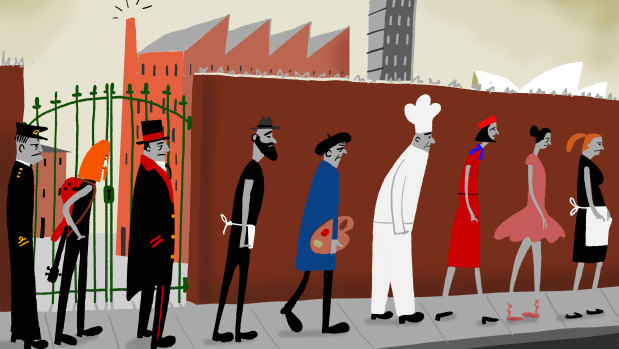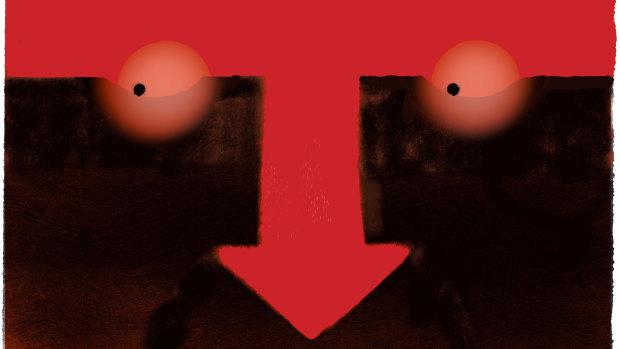This was published 4 years ago
Opinion
Hard lessons on how recessions work and why we hate them so much
Ross Gittins
Economics EditorForgive me for boasting about how old I am, but this coronacession – aka the Great Lockdown – will be the fourth severe recession of my career as an economic journalist. That makes recessions my special subject, though I’ve not had much call to talk about them for almost 30 years.
I was too young to remember much of Bob Menzies’ Credit Squeeze, which came within a whisker of tossing him out of office in 1961. But I was established in journalism before I saw the recession of the mid-1970s add the last nail to the coffin of the Whitlam government.
Malcolm Fraser’s prime ministership was cut short by the recession of the early 1980s. Bob Hawke’s successor, Paul Keating, should have been dispensed with at the 1993 election after the recession of the early 1990s, but was saved by our inordinate fear of Dr John Hewson’s proposed goods and services tax. By the next election in 1996, however, voters were on their verandahs with baseball bats waiting for Keating.
So, lesson No. 1: governments that preside over recessions usually get the blame for them. Lesson No. 2: in Australia, recessions happen roughly every seven years – or so I imagined at the time.
When the financial crisis of 2008 failed to sweep us into the world’s Great Recession, I was denied what I fondly assumed would be the biggest recession of my career. Why? Because Kevin Rudd did exactly what his econocrats told him to – and it worked.
In truth, we did have a recession, but one too small to remember. Another truth: more than a decade later, our economy had still not got back fully to normal and was in a weak state when the virus hit us some weeks ago.

Illustration: Simon LetchCredit:
In the decades since our last experience of severe recession, silly people in the financial markets and the media have given us the impression that a recession consists of real gross domestic product falling for two quarters in succession.
If you haven’t already, you’ll soon realise what nonsense that is. Lesson No. 3: the defining, terrible characteristic of recessions is soaring unemployment. That’s what makes people fear them so much. “What if I lost my job? How would I pay the mortgage? What about my kids? I’ve got one just finishing uni. Oh, what an appalling stuff-up. Those politicians are hopeless.”
Recessions inflict great harm on those who lose their jobs or their businesses. They make people terribly anxious. They heighten money worries and fights between spouses. They kill off any optimism about the future, leaving the public depressed and surly for month after month. They bark at every economist.
Lesson No. 4: unemployment shoots up, but crawls back down. I remember how much fuss there was when the number of unemployment benefits hit a million under the Hawke government. Last week Scott Morrison announced that, in just a few weeks, the number of people on the JobSeeker allowance (the latest in a long list of bureaucratic euphemisms for the dole) had topped 1.3 million – with a further 300,000 applications to be processed.

Illustration: Andrew DysonCredit:
After the Hawke-Keating recession (the one we didn’t really have to have), it took almost 14 years for the rate of unemployment to get back down to the 5.9 per cent it was in November 1989.
And research by Professor Bob Gregory, of the Australian National University, suggests that people who’ve been unable to find a job for two years are unlikely to find one again. In recessions past, governments have hidden away some of these people by putting them on the disability pension.
In this recession, the new JobKeeper payment – a worthy measure – is helping to understate the number of workers counted as unemployed.
Lesson No. 5: though economic journalists make much of unemployment statistics, what brings the reality of high unemployment home to the public is TV footage of ashen-faced workers streaming out of factory gates after being laid off.
What did it this time was footage of all those young people queuing up the street and around the corner from Centrelink. Lesson No. 6: this recession, like all of them, will hit the young hardest, particularly those leaving the education system to start working. As part of this, the low-skilled are always hit harder.
What’s different this time – due to the recession’s unique cause: the government hitting the economy on the head with a hammer – is that job losses are so heavily concentrated in a few sectors: tourism and hospitality, arts and entertainment, and universities.
My final lesson is that public attitudes towards the unemployed are cyclical. Between recessions, many people see them as too lazy to work. Come the next recession, however, and we ooze sympathy. We know people who’ve lost their jobs and we’re hoping neither we nor our kids will be joining them.
So, give the jobless a hard time with pettifogging officiousness, robo-debt, payment by card not cash, Work for the Dole, drug testing, reverting to $40 a day? No, wouldn’t dream of it. Not if you’re hoping to be re-elected.
Ross Gittins is the Herald’s economics editor.